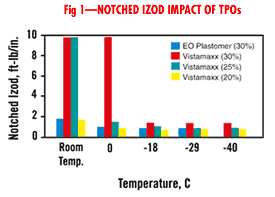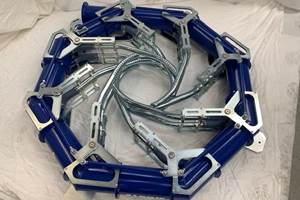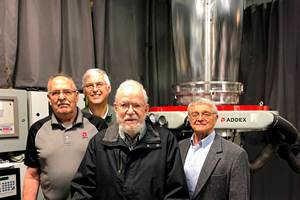New Metallocene TP Elastomers Tackle Films, Fibers, TPOs
The Vistamaxx family of propylene-ethylene specialty elastomers recently unveiled by ExxonMobil Chemical (see Your Business In Brief, August 2003) holds promise in a broad range of applications from very soft fabrics and films to very hard TPOs.
The Vistamaxx family of propylene-ethylene specialty elastomers recently unveiled by ExxonMobil Chemical (see Your Business In Brief, August 2003) holds promise in a broad range of applications from very soft fabrics and films to very hard TPOs. Made with the company’s Exxpol metallocene catalyst technology and a new solution polymerization process, Vistamaxx thermoplastic elastomers can be used on their own or as modifiers for other polyolefins. They will be commercially available within the first half of 2004 from a new plant being built in Baton Rouge, La.
Described as having a special semi-crystalline structure, Vistamaxx is said to be very compatible with other polymers and very easy to process. Properties of the new elastomers can be tailored for specific applications through control of molecular weight, MW distribution, composition distribution, and degree of crystallinity (see Table 1, below).
Initial targets include elastic nonwoven fabrics for medical apparel, personal care, and even car-seat covers. According to product development manager George Racine, elasticity has been lacking in the widely used polypropylene nonwoven fabrics.
| Table 1—Property Range of Vistamaxx TP Elastomers | |
| Density, g/cc MFR, g/10 min Mooney Viscosity, ML Tg, C Melting Point, C Hardness, Shore A Tensile Str., psi Elongation, % Elastic Recovery, % | 0.86 - 0.89 1 - 25 10 - 30 -10 to -13 40 - 160 50 - 90 1200 - 3500 100 - 1500 80 - 97 |
Vistamaxx elastomers are also aimed at elastic films, TPO modification, and tie layers for polyolefin-to-polyolefin bonding. Their advantages in these applications are said to include elasticity, adhesion, softness, and toughness. Markets range from automotive interior and exterior parts to packaging, personal care, and wire/cable.
Elastic cast films
Mono- or multi-layer cast films that require elasticity—such as baby diapers and hospital gowns—are promising applications for Vistamaxx. The key is that these films can be processed on conventional polyolefin cast film equipment, notes Hans Van Brackle, global technology manager. Vistamaxx can be used on its own or in blends to deliver elastomeric properties plus the processability of PE and PP. Resulting films can compete with polyurethanes, SEBS, and other styrenics. Films have been produced with a density of less than 1.0 g/cc, tensile strength of more than 3000 psi, and secant modulus of 2350 to 3240 psi (Table 2).
Some applications require a film to maintain its key properties at elevated temperatures in storage and use. Tests of Vistamaxx cast films showed no change in modulus from room temperature to 212 F. In contrast, film of a 0.870-g/cc ethylene-octene plastomer suffered a significant decrease in modulus around 94 F.
Impact modification
Vistamaxx elastomers also are said to be well suited to impact modification of high-flow PP homopolymers and impact copolymers. ExxonMobil is initially targeting TPO auto exterior and interior trim. Racine says non-automotive TPO applications in household goods and healthcare are also being explored.
Trials have shown that TPO compounds made with the new elastomers combine excellent impact properties with higher stiffness and flow than typical TPOs utilizing low-density ethylene copolymers such as ethylene-propylene or ethylene-octene plastomers. This benefit is achieved with a lower loading of Vistamaxx modifier, which has the added advantage of reducing cost.
| Table 2—Cast Film Properties | |
| Gauge, mil Elmendorf Tear, g/mil MD TD Tensile strength, psi MD TD Break Elongation, % MD TD Secant Modulus, psi MD TD Tensile Set-First Cycle, % MD TD Tensile Set-Second Cycle, % MD TD | 4.5 96 100 3050 2660 750 830 3240 2350 12 9 7 5 |
Recent trials demonstrated the impact properties of blends of a 35 MFR PP and a 0.860-g/cc octene plastomer at 30% loading compared with those of a Vistamaxx elastomer of similar density at various loadings (Fig. 1). At loadings of 30% and 25% Vistamaxx, the impact properties at room and low temperatures are substantially better than those of the plastomer blend. With a loading of 20% Vistamaxx, the impact properties are equivalent to that of the blend containing 30% of the plastomer.
At the 20% loading, flexural modulus of the Vistamaxx blend is 150,000 psi vs. 100,000 psi for the plastomer blend. In addition, the MFR of the Vistamaxx blend is around 21 g/10 min vs. about 14 g/10 min for the plastomer blend.
Good polyolefin adhesion
Vistamaxx elastomers have excellent compatibility with other poyolefins in coextrusion or overmolding. ExxonMobil is exploring the materials’ adhesion to PP or EPDM at bonding temperatures below those of standard polyolefin processing. According to Racine, potential applications range from packaging and consumer goods to auto interior trim. Vistamaxx could eliminate the need for adhesives and high bonding temperatures that can adversely affect the materials being joined.
Adhesion trials show the excellent compatibility of Vistamaxx with PP. Results of T-peel tests on a three-layered laminate with Vistamaxx on the outside and PP or HDPE in the center appear in Fig. 2. Vistamaxx shows excellent adhesion to PP at bonding temperatures above and below the melting temperature of PP. Adhesion is very high even at temperatures as low as 120 C (248 F), which is about 45° C (81° F) below the melting point of PP. However, Vistamaxx shows poor bonding to HDPE.
Related Content
Variable-Diameter Air Ring Cools Film Above Frost Line
Tower-mounted adjustable ring adds cooling so that blown film can run at optimum line speeds with structures having soft inner skin layers that tend to block.
Read MoreBreaking the Barrier: An Emerging Force in 9-Layer Film Packaging
Hamilton Plastics taps into its 30-plus years of know-how in high-barrier films by bringing novel, custom-engineered, nine-layer structures resulting from the investment in two new lines.
Read MorePregis Performance Flexibles: In the ‘Wow’ Business
Pregis went big and bold with investment in a brand-new, state-of-the-art plant and spent big on expanding an existing facility. High-tech lines, well-known leadership and a commitment to sustainability are bringing the “wow” factor to blown film.
Read MoreAir Ring Add-On Brings Output to New Level
The Short Stack from Addex sits between the air ring and die and provides high-velocity air flow to boost output and lock in the bubble.
Read MoreRead Next
Understanding Melting in Single-Screw Extruders
You can better visualize the melting process by “flipping” the observation point so that the barrel appears to be turning clockwise around a stationary screw.
Read MoreAdvanced Recycling: Beyond Pyrolysis
Consumer-product brand owners increasingly see advanced chemical recycling as a necessary complement to mechanical recycling if they are to meet ambitious goals for a circular economy in the next decade. Dozens of technology providers are developing new technologies to overcome the limitations of existing pyrolysis methods and to commercialize various alternative approaches to chemical recycling of plastics.
Read MoreProcessor Turns to AI to Help Keep Machines Humming
At captive processor McConkey, a new generation of artificial intelligence models, highlighted by ChatGPT, is helping it wade through the shortage of skilled labor and keep its production lines churning out good parts.
Read More



























